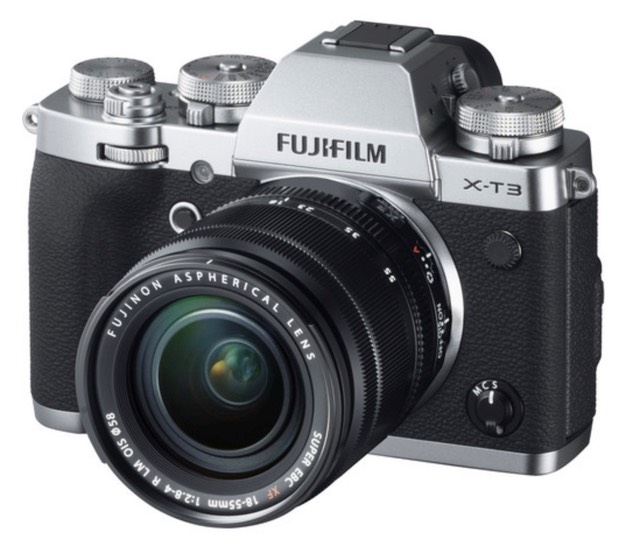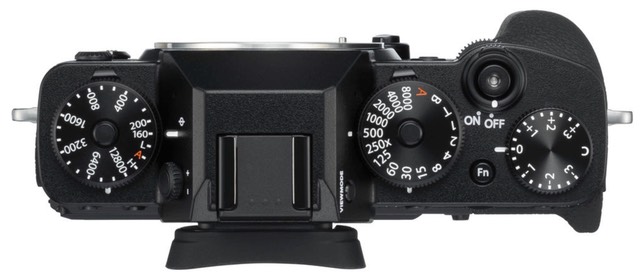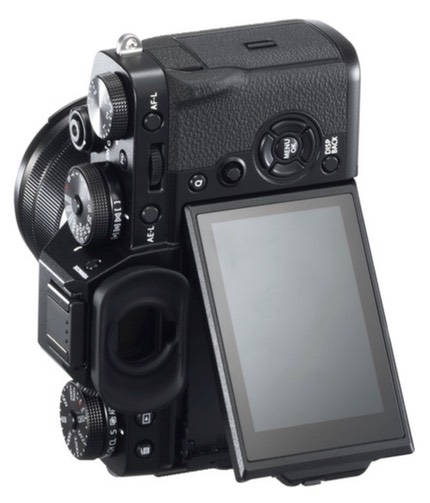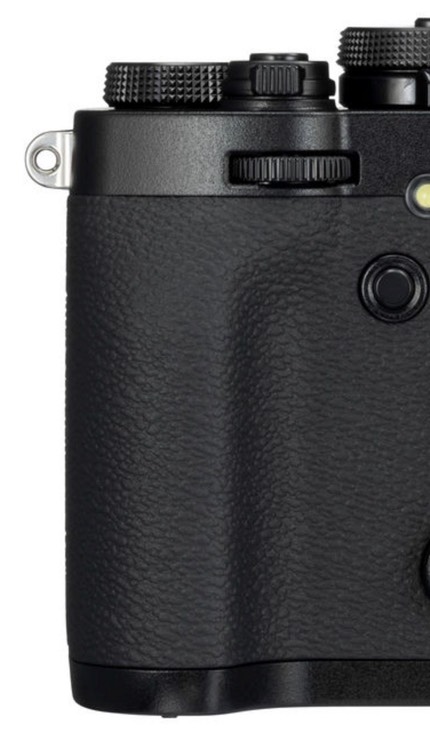
What is It?
The X-T3 is the third in the line that seems to be driving much (if not most) of Fujifilm's camera improvements. The single digit X-T's are arguably Fujifilm's top APS-C cameras (despite the appearance of the X-H1 and the seminal nature of the X-Pro1). If you don't call the single digit X-T's "top", then you should probably call them "most important."
That's for a couple of reasons. First, the single-digit X-T's also drive the double digit X-T's (e.g. X-T1/X-T10, X-T2/X-T20, and now X-T3/X-T30). We get a pair of cameras where one is fully featured and extremely DSLR-like, while the other has a slightly reduced feature/performance set, and is a smaller version, less robust version using much the same technology.
At the sensor, that means that we've gone from 16mp X-Trans (X-T1) to 24mp X-Trans (X-T2) to now 26mp X-Trans (X-T3). But plenty of other things have transitioned with these cameras, too:
| X-T1 | X-T2 | X-T3 | |
|---|---|---|---|
| Sensor | 16mp FSI | 24mp FSI | 26mp BSI |
| base ISO | 200 | 200 | 160 |
| autofocus | PF 37% coverage | PD 37% coverage | PD 95% coverage |
| shutter |
1/4000, 8 fps | 1/8000. 14 fps | 1/8000, 20 fps |
| EVF | 2.36 dot, 60Hz | 2.36m dot, 100hz | 3.69m dot, 100Hz |
| LCD touchscreen | No | No, dual tilt | Yes, dual tilt |
| Connectivity | Wi-Fi | Wi-Fi, | Wi-Fi, BT |
| Cards | Single UHS II | Dual UHS II | Dual UHS II |
| Video | 1080/60P max | 4K/30P max | 4K/60P max |
| Weight | 440g | 507g | 539g |
| Introduced | Jan 2014 | July 2016 |
Sept 2018 |
It appears that Fujifilm is iterating the single-digit X-T models on just slightly more than a two year basis, so an X-T4 wouldn't be expected until early 2021.
Let's dive a little deeper.
The 26mp sensor at the heart of the X-T3 (and X-T30) is basically a state-of-the-art Sony Exmor BSI sensor with Fujifilm's unique X-Trans toppings (as opposed to Bayer). Fujifilm calls this the X-Trans IV.
While pixel increase is minimal, the switch to BSI increases the fill factor enough that the net effect should be that the new sensor has similar properties to the lower pixel count one it replaces.
It doesn't get talked about quite as much, but the X Processor 4 imaging ASIC now has four CPU cores and runs about three times faster than the X-T2. That's driving a lot of the performance of these new models.
Video has been pushed to a maximum of 4K at 60P. This comes from a ~1.2x crop region of the sensor and can be in either the UHD or DCI form or 4K. If you drop to 4K and 30P, the full sensor width is used. Fujifilm also supplies an F-Log capability for video, and records 10-bit 4:2:0 internally as opposed to 8-bit (you can get 10-bit 4:2:2 over the HDMI port). Video is recorded in H.265 (most other cameras are still using H.264).
Both headphone and microphone sockets are on the camera, and there are plenty of additional small video tweaks that make this arguably Fujifilm's best video-capable still camera to date (the X-H1 lacks 4K 60P, though does have image stabilization).
The on-sensor phase detect system has been expanded to nearly the full frame (91% of the width, 95% of the height), and you can get full frame 20 fps shooting with the electronic shutter (30 fps with a 1.25x crop in the new Sports Finder mode). The mechanical shutter is limited to 11 fps.

While the X-T3 is said by many to be very SLR like due to its plethora of old-school dials and rings, it really is old school: the right hand grip is really a bumped out ridge more than a hand grip (ala what the DSLRs did). The good news is the the bump is sculpted on the side your fingers will dig into, so it does function as a minimal hand grip.
I mentioned dials and rings: ISO, shutter speed, exposure compensation, front control, rear control, drive selection, and metering all get dedicated dials/rings. Fujifilm lenses marked R have an aperture ring, too. One thing I've noted is that, for many, this is one of the big deciding points for shifting to the X-T's: their controls remind their users of the old SLR they used years ago.
I mention that for a reason: I'm not sure that the X-T3 design ethos appeals to the younger crowd, who'd probably appreciate more touch and modern-type control. (The X-T3 has some touchscreen abilities, but not as much or as extensive as you see on some cameras now. Touch AF seems slower than using other focus methods.) Thus, I wonder whether or not Fujifilm is limiting themselves in terms of market due to their SLR-like designs. I'm fine with their SLR-ness, but I, like many of those that appreciate a full set of dials, am aging slowly out of the buying public.
As befitting a professional-type camera, there's a great deal of customization that's available on the X-T3. Fujifilm's menus have grown some trying to accommodate all that. The menus really could now benefit from a complete help system. The command dials both press in as an additional button capability. We've also got a PC Sync socket, which is kind of old school, too, but should be welcome for studio shooters.

In terms of displays, Fujifilm is still using the same 3.2" 1m dot basic display you see on most of their models, but on the X-T3 it can tilt up/down, plus by unlocking it from the frame that holds it, it can also tilt to the side, as well. While not as flexible as the fully pivoting LCDs on a few cameras, it is nice that you can see the LCD with the camera held over your head in a vertical shooting position.
The EVF is a 3.7m dot OLED running at a magnification of .75x. That's a small bit down from the .77x of the X-T2, but not noticeable. What is noticeable is the 1280x960 equivalent pixel display is more detailed, and the 23mm eyepoint lets most eyeglass wearers see the whole frame. There's a big diopter range of -4 to +2 to correct for your vision if you don't want to use your glasses. Maximum refresh rate is 100Hz, but for battery sake, it normally runs at 60Hz.

In terms of connectivity, the X-T3 uses USB-C and micro HDMI, and has both Wi-Fi and Bluetooth. The door over the connectors (including mic and headphone) is removable, a nice touch, though the flimsy plastic retainer may be a problem over time if you're taking it on and off a lot.
One nice touch is that you can remote control the camera via an old-style cable shutter release cable, a dedicated Sony wired remote, and your smartphone using Fujifilm's app, which is pretty well behaved, though somewhat simple.
You also get two matched SD (UHS-II) card slots. Thank you, Fujifilm. The companies making expensive cameras with mismatched slots drive me crazy, as you're always limited by the slowest slot if you try to use both.
The battery is still the venerable NP-W126S, which the CIPA rating says should last for 390 shots. That's a bit more than you usually see on the high-end cameras, and testament to the fact that Fujifilm has some power-conservation features in the camera to try to keep you shooting (which you can override).
An optional VG-XT3 grip adds vertical controls, and provides the capability to use up to three batteries with the camera simultaneously. If you're shooting long sessions or events, you might want to look into that.
The X-T3 is made in China, and comes in all-black or panda (silver over black) versions. Suggested list is US$1500. Even though this is a very recent camera, it is currently on firmware 3.x, so make sure you check to see if the body you buy has been updated to current firmware.
Source of the reviewed camera: long-term loan from B&H
Fujifilm's Web page for the camera
How's it Handle?
You either like dials or you don't. If you do, then Fujifilm's current implementation on the X-T3 is quite good. Both the ISO and shutter speed dial are lockable, something that is welcome even though both dials are not particularly easy to move accidentally.
As with the X-H1, there are things I'd really like to have seen Fujifilm do, such as make the AF-On button more distinctive from the AE-L button. Likewise, the Fn buttons are tough to find by touch and small. At least the Q button is in a place where it doesn't tend to get accidentally pushed, as it is on the X-H1.

To me, though, the real deciding point for most is going to be that hand grip. As I note, it's not a deep, substantive grip as you find on the DSLRs. Finger grip is via a small sculpting of a bumped out area (see above). Even though this is covered in Fujifilm's faux leather rubberization material, I find the grip a little slippery. Enough so that I don't one-hand the X-T3 as I can with some similar-sized cameras. And I don't have large hands or long fingers, so I wonder what those with big mitts would say about the grip.
Still, this is a well thought out and well behaved camera in terms of handling. Most of my complaints are all in the "nit" category. It is frustrating, however, that Fujifilm came so close to getting everything right, then cheaped out on some small buttons and a few other items.
My only comment is to verify that you're happy with your right hand position on an X-T3 before committing to it. The X-H1, with it's deeper grip, may be the better camera for some people just on that alone.
How's it Perform?
Battery: I got somewhat more than the CIPA stated average over most sessions, so I'm comfortable saying that you should expect at least 400 shots per charge in regular shooting, and probably something more like 500. I got more than that on one session. I'd say that the X-T3 is a little better tuned to the battery than the X-H1 and X-T30 for some reason.
Focus: For most uses, I have no real issues here. In well lit and contrasty situations with non-moving or slow-moving subjects, the system is fast and precise. AF-S (single servo focus) users should have virtually no issue with the camera, particularly if they stick to the central section covered by phase detect sensors.
Tracking focus is a bit different.
We have the usual Eye Detection ability in the more automatic focus modes, and it works very well. As I noted with the X-T30, though, when the camera or subject is moving fast, there can be a slight moment where the eye is lost and the camera drops back to Face Detection while it re-looks for the eye. Eye Detection can be "auto" or you can pick left or right eye (but not closer eye). Like most Eye Detection systems, there can be a tendency to focus on the eyebrows/eyelashes, though Fujifilm is the only system I know of that actually tries to detect using the eye itself; you can see that at work at times when the small detection box goes horizontal instead of a small rectangle.
Where I'm not sure Fujifilm has caught state-of-the-art with autofocus is in tracking erratic, fast motion using AF-C (continuous servo focus). Because most of my sports coverage is shut down in the summer months as I was testing these cameras, I wasn't able to do all the testing I would have liked, but in some mountain biker testing I could see the system struggle to keep the subject in tight focus.
Let me try to describe that more carefully. On my D5, a sequence that achieves focus pretty much stays locked on the thing that was originally focused. If you look at the eyes of a soccer player, for instance, every frame has the same focus plane (and if I used the AF system right, that's the player's eyes). On the Sony systems, one of the things I don't like is that there is some "drift" of the focus plane, even on the A9, which is the best of the bunch. The focus plane doesn't move much, but in that same soccer player scenario it'll drift forward and back of the actual eye by a millimeter or two from frame to frame.
The X-T3 (and X-T30) sort of match the Sony performance if the subject is well centered and coming directly at you at a constant speed: a bit of fore/aft drift, but very acceptable focus. But if the subject is moving more erratically (across the frame), I see clear focus "misses." Not by a lot. But focus just in front of the face or back on the ears is often enough to just give me undesirable results, particularly with the faster lenses used wide open.
The X-T3 (and X-T30) do get some frames in focus in erratic sequences, but it's the front/aft focus drift during a burst sequence that I find to be the issue: it's just a bit too much drift for me to have long, usable sequences. Tinkering with the AF-C Custom Settings helps, and I'm not sure I've mastered those yet. That would take a lot more shooting under conditions I couldn't test the cameras in during my two months with them. But take that to be a warning that you'll need to spend some time with the AF-C system learning how it responds and tuning it in order to get the best possible results out of this camera.
To put things in perspective, ten years ago we would have been 100% happy with the Fujifilm's AF-C performance in bursts. Today? Not so much. I'd judge Fujifilm to be a generation or two behind where the best mirrorless cameras are today. Thing is, that's for an extreme use of the camera (e.g. action sports). Not a lot of people are buying these cameras for that type of work, so the extreme AF-C testing might not be relevant to you. The AF-S and AF-C for event-type shooting works fine, and face/eye detection works as you'd expect in those conditions. It's only when I press the system to the toughest fast moving subjects that I start to find issues.
Image Quality: In my experience, a majority of the Fujifilm faithful like their cameras for one thing: Fujifilm color in JPEG shooting. Fujifilm uses a double hue shift in many of their JPEG settings, they also tend to have a bit of extra saturation, and they tend to be slightly higher in contrast than others (though not as high as the Olympus defaults). Greens go a little yellow, as do reds. Blues tend to be royal blue.
All these things are well researched attributes that Fujifilm knows viewers react favorably to. Moreover, the different basic choices (faux* Provia, Velvia, Astia, Classic Chrome, Pro Neg, Eterna, and Acros), are very nicely chosen as providing easily perceived differences, something not all of the camera makers have managed to achieve without resorting to Instagram-like filtration.
*I use the word faux here because not any of these digital effects match the spectral qualities of the film they're named for. Digital Velvia, for instance, looks nothing like Film Velvia, though it does boost saturation and increase contrast, two traits that many equate to the film stock. However, I don't see the magenta shift, nor the fast slope to pure black of the film stock in the digital implementation, among other things.
Suffice it to say that Fujifilm has made clear, wise choices in their JPEG settings, and out-of-camera images tend to be quite good, and most will find them pleasing. I personally prefer more neutral results than the X-T30 can produce, but most people shooting JPEG aren't going to be post processing. I'd advise them to put some time and energy into understanding how the different film simulations work in different situations, and pick the right one for each scene.
In evaluating raw images, things get a little more complex. One thing I wasn't expecting was to see a meaningful difference in noise between the X-T3/X-T30 and the previous generation, but it's there. Exposed and evaluated purely equivalent, the newer generation 26mp sensor produces a tiny bit more visual noise than the older 24mp sensor, emphasis on the word tiny. In terms of actual measurement, the values and standard deviations look the same, though. Which means that it's the "texture" of the noise that has changed slightly, not the amount of it. This shows up most clearly at very extreme high ISO values, but I'm pretty sure I still see it even down to the base ISO.
I actually don't judge that to be an issue, as the previous generation sensor was essentially built on a Sony Exmor base, and that has proven to be a winning combination. In terms of APS-C sensor use, though, I'd judge the most recent Nikon DSLRs and Sony mirrorless to be ever so slightly better than the Fujifilm mirrorless (emphasis on the word "slightly"). The Fujifilm mirrorless cameras are clearly and significantly better than the Canon APS-C mirrorless cameras for raw shooting, no questions asked
Final Words
I can't say I'm in love with the X-T3, just considerable like. As with the X-H1, a part of this boils down to the fact that the X-T3 is getting up into the DSLR size/weight category and that some of the recent full frame mirrorless cameras are actually smaller now (e.g. Sigma fp).
To me the X-T3 really is going up against cameras such as the Nikon D500. The Fujifilm gets a series of pros in that comparison (manual controls, more flexible LCD, the value of WYSIWYG with the EVF, some additional video capability, and even some extra pixels (26mp versus 20mp)). The D500 has better autofocus for fast moving and erratic subjects, and a better set of telephoto lens options.
So, as I've pointed out in the other reviews I'm posting today, a lot of how you evaluate the X-T3 is going to come down to what you're shooting, and what your preferred lens choices are. For travel, family, and event shooting, particularly with primes below 100mm, the X-T3 has tons of appeal that shouldn't be underestimated. Double that if you shoot mainly JPEG, as the Fujifilm out-of-camera choices are flexible and good.
But you also have to consider the X-H1 in those cases. It adds image stabilization and costs less. (Own goal, Fujifilm.) Personally, that's the way I'd go as I write this, despite my frustration with the Q button's location on the X-H1. That said, you can't go far wrong with either camera if you love primes, old-school controls, and solid performance.
2022: this model is out of production and no longer available new. But used copies can easily be found. Also, check out the current X-T4.
Recommended (2019, 2020, 2021)